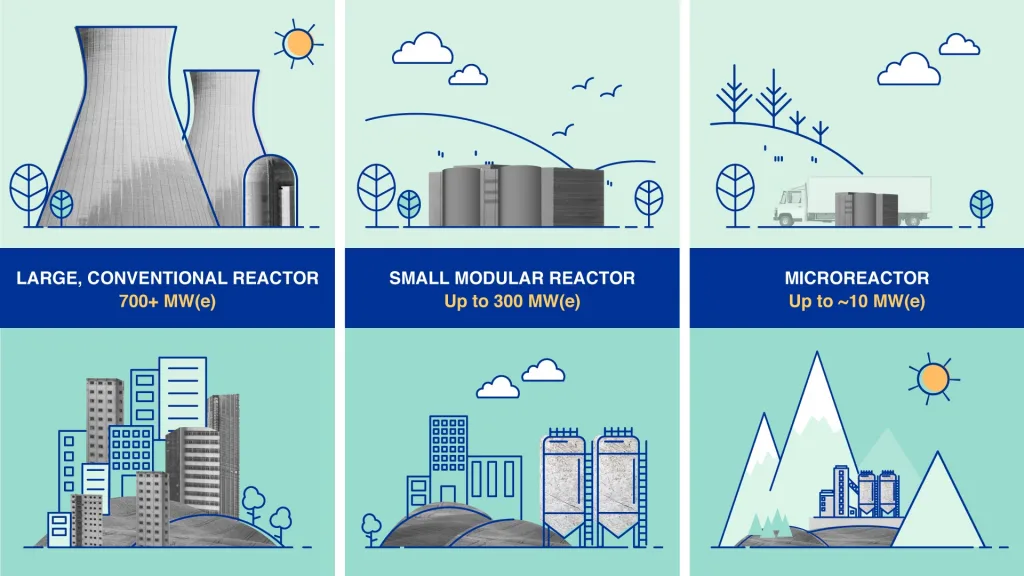Syllabus: GS3/Energy Resources; S&T
Context
- As the world shifts towards a low-carbon energy landscape, India’s focus on Small Modular Reactor (SMR) signals a transformative approach to nuclear energy that aligns well with its broader vision for sustainable energy security.
About the Small Modular Reactors (SMRs)
- These are a type of nuclear reactor designed to be smaller in size and capacity compared to traditional nuclear reactors. Typically, SMRs have a capacity of up to 300 megawatts (MW), which is about one-third of the generating capacity of traditional nuclear power reactors.
- Small – physically a fraction of the size of a conventional nuclear power reactor.
- Modular – making it possible for systems and components to be factory-assembled and transported as a unit to a location for installation.
- Reactors – harnessing nuclear fission to generate heat to produce energy.
- Their modular nature allows them to be factory-built and then transported to the site, which reduces construction time and costs.

Potential Applications
- SMRs can be particularly beneficial in repurposing retiring coal-based thermal power station sites, thus aiding in the coal-to-nuclear transition.
- This approach not only leverages existing infrastructure but also addresses land acquisition and displacement issues.
- Additionally, SMRs can support grid stability and energy security, complementing renewable energy sources like solar and wind.
Advantages of SMRs
- Enhanced Safety: SMRs are designed with fewer operating parts and incorporate advanced safety features, making them inherently safer. Their smaller size allows for better control and management of nuclear reactions.
- Cost-Effective: SMRs can be factory-fabricated and transported to the site, significantly reducing construction time and costs. This approach also minimises the financial risks associated with large-scale nuclear projects.
- Flexibility and Scalability: Unlike large nuclear plants, SMRs can be constructed in a modular fashion, allowing for incremental capacity additions. This flexibility makes them suitable for a variety of applications, including remote locations and industrial sites.
- Environmental Benefits and Support for Decarbonisation: By providing a reliable and continuous supply of low-carbon electricity, SMRs can play a crucial role in reducing greenhouse gas emissions and supporting industrial decarbonisation.
- Utilisation of Existing Infrastructure: SMRs can be installed at decommissioned thermal power plant sites, repurposing existing infrastructure and reducing the need for new land.
Challenges
- High Initial Costs: Although SMRs are designed to be more cost-effective in the long run, the initial capital investment is significant. It includes the costs of developing new technologies and building the reactors.
- Regulatory Hurdles: The regulatory framework for SMRs is still evolving. Ensuring safety and security while streamlining the approval process is a complex task.
- Proliferation Risks: SMRs, like all nuclear technologies, pose risks related to the proliferation of nuclear materials. Ensuring that these reactors are resistant to misuse for military purposes is crucial.
- Waste Management: Handling and disposing of nuclear waste remains a significant challenge. SMRs produce less waste than traditional reactors, but the issue of long-term storage and environmental impact persists.
- Public Perception: There is often public resistance to nuclear energy due to safety concerns, especially after incidents like Fukushima. Gaining public trust and acceptance is essential for the deployment of SMRs.
- Grid Integration: Integrating SMRs into existing power grids can be challenging. They need to be compatible with current infrastructure and capable of providing stable power supply.
- Supply Chain and Manufacturing: Developing a robust supply chain for the components of SMRs and ensuring quality manufacturing processes are critical for their success.
India’s Approach to SMRs
- India, through various initiatives and collaborations, is actively exploring the potential of SMRs, highlighted that SMRs offer significant savings in cost and construction time and are crucial for achieving India’s net-zero emissions target by 2070.
- The NITI Aayog, in collaboration with the Department of Atomic Energy, has been at the forefront of these efforts.
- According to a report by NITI Aayog, SMRs are seen as a critical technology for industrial decarbonization and energy transition.
Current Developments
- Research and development on SMRs are ongoing at the Bhabha Atomic Research Centre (BARC) in Mumbai.
- The Bharat Small Reactor (BSR) is a notable project under this initiative which aims to re-engineer existing reactors to incorporate additional safety features and enhance their efficiency.
- India plans to deploy 40-50 SMRs to replace captive thermal power plants, aligning with its goal of achieving net-zero emissions.
- These reactors are expected to play a significant role in India’s energy mix, providing a reliable and continuous power supply.
International Cooperation in Advancing SMRs in India
- United States: India and the US are expanding their strategic ties to include the joint development of next-generation SMR technology. It aims to accelerate India’s energy transition and enhance its energy security.
- France:India and France have launched a cooperation program focused on SMRs and advanced modular reactors (AMRs).
- The two countries are collaborating on the Jules Horowitz Research Reactor, which will aid in the development of nuclear technologies.
- Russia: Russian industrial houses have expressed interest in sharing advanced SMR technology with India. It was highlighted during the recent Energy Transition Working Group (ETWG) meeting in Mumbai.
Conclusion and Future Prospects
- As India continues to explore and invest in clean energy technologies, Small Modular Reactors offer a viable and promising solution.
- Despite several challenges, the potential of SMRs to provide clean, reliable, and scalable energy solutions makes them a key component of India’s energy strategy.
- As the country progresses towards its ambitious energy goals, SMRs could play a pivotal role in ensuring a sustainable and secure energy future.
| Daily Mains Practice Question [Q] Do you believe that Small Modular Reactors (SMRs) hold the potential to revolutionise India’s energy landscape by providing a reliable, clean, and sustainable energy source, or are there significant challenges and risks associated with their deployment that outweigh their potential benefits? |